Report on The Dynamics of Leadership in Accord Group
VerifiedAdded on 2020/12/28
|22
|7258
|295
Report
AI Summary
This report delves into the dynamics of leadership within the Accord Group of Companies, exploring various facets such as the differences between leaders and managers, leadership development, and methods for measuring leadership success. It examines different types of followership and the relationship between leaders, followers, and the environment. The report also analyzes the impact of values, personality, power, and influence on leadership, along with the implications of cultural differences. Furthermore, it compares teams and groups, discusses leadership in a team context, and explores how leaders influence follower motivation and satisfaction. The study also covers the impact of organizational factors, task interdependence, and the influence of the legal, political, and economic environment on leadership. Finally, it analyzes both rational and emotional approaches to organizational change, providing a comprehensive overview of leadership principles and practices within the context of the Accord Group.
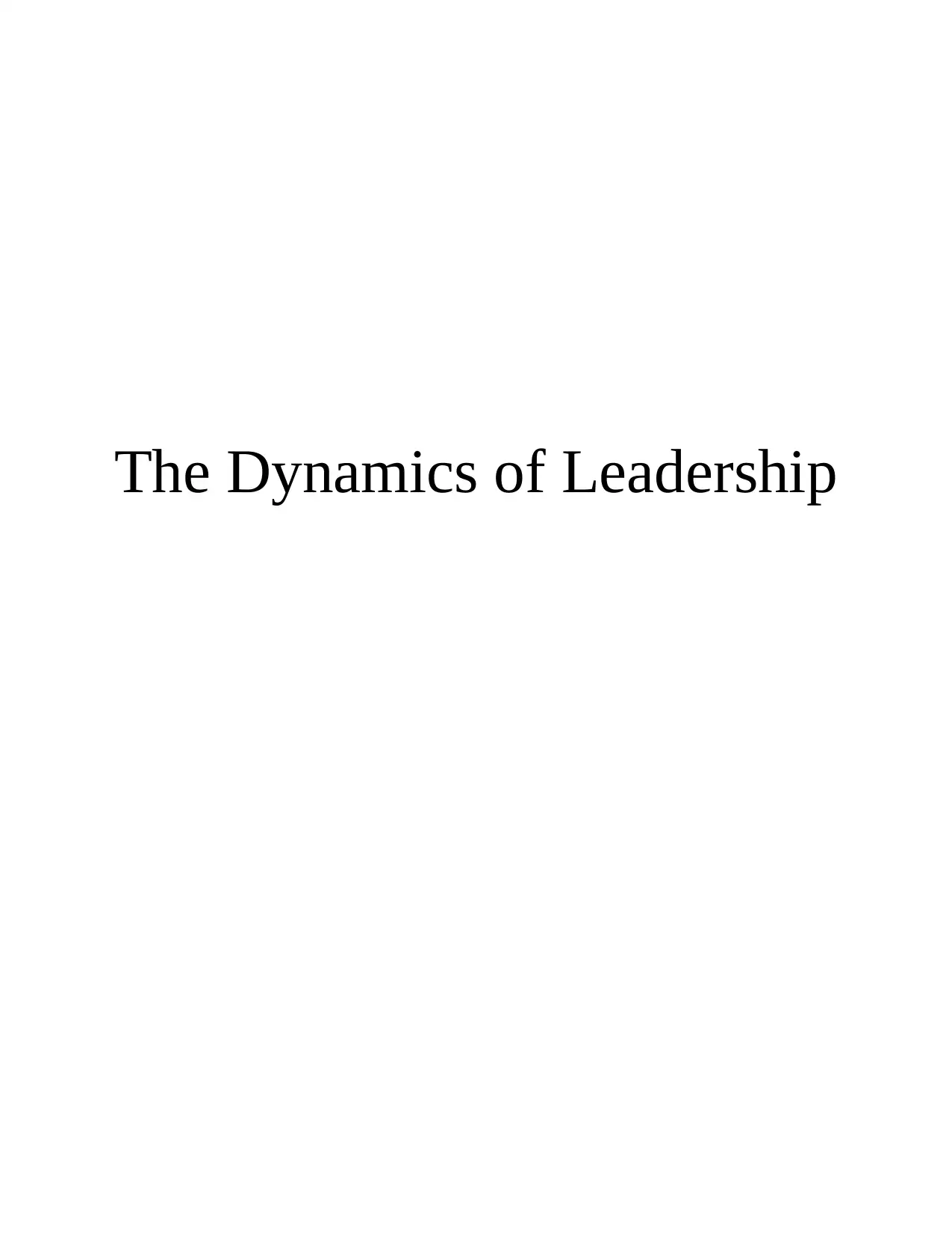
The Dynamics of Leadership
Paraphrase This Document
Need a fresh take? Get an instant paraphrase of this document with our AI Paraphraser
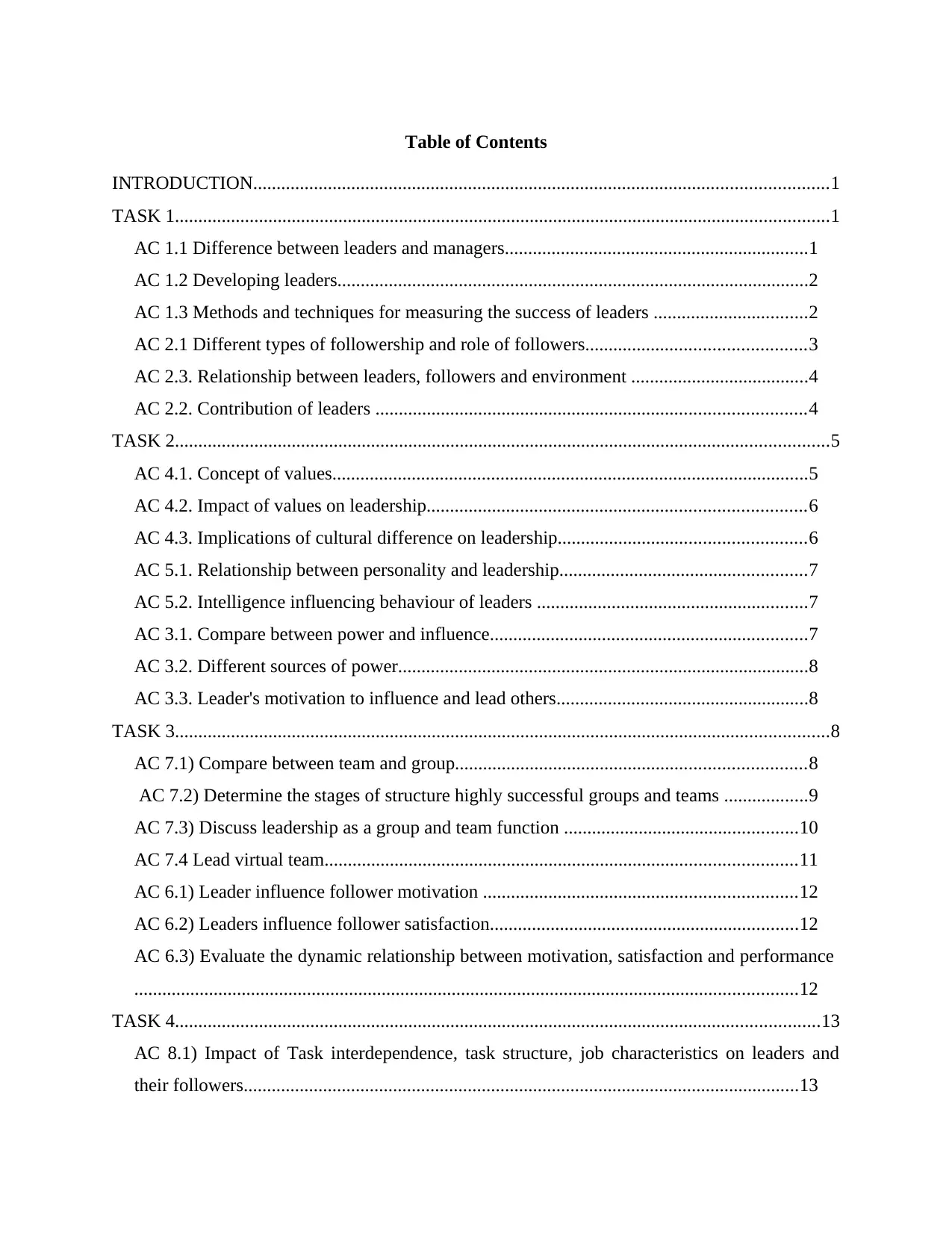
Table of Contents
INTRODUCTION...........................................................................................................................1
TASK 1............................................................................................................................................1
AC 1.1 Difference between leaders and managers.................................................................1
AC 1.2 Developing leaders.....................................................................................................2
AC 1.3 Methods and techniques for measuring the success of leaders .................................2
AC 2.1 Different types of followership and role of followers...............................................3
AC 2.3. Relationship between leaders, followers and environment ......................................4
AC 2.2. Contribution of leaders ............................................................................................4
TASK 2............................................................................................................................................5
AC 4.1. Concept of values......................................................................................................5
AC 4.2. Impact of values on leadership.................................................................................6
AC 4.3. Implications of cultural difference on leadership.....................................................6
AC 5.1. Relationship between personality and leadership.....................................................7
AC 5.2. Intelligence influencing behaviour of leaders ..........................................................7
AC 3.1. Compare between power and influence....................................................................7
AC 3.2. Different sources of power........................................................................................8
AC 3.3. Leader's motivation to influence and lead others......................................................8
TASK 3............................................................................................................................................8
AC 7.1) Compare between team and group...........................................................................8
AC 7.2) Determine the stages of structure highly successful groups and teams ..................9
AC 7.3) Discuss leadership as a group and team function ..................................................10
AC 7.4 Lead virtual team.....................................................................................................11
AC 6.1) Leader influence follower motivation ...................................................................12
AC 6.2) Leaders influence follower satisfaction..................................................................12
AC 6.3) Evaluate the dynamic relationship between motivation, satisfaction and performance
..............................................................................................................................................12
TASK 4..........................................................................................................................................13
AC 8.1) Impact of Task interdependence, task structure, job characteristics on leaders and
their followers.......................................................................................................................13
INTRODUCTION...........................................................................................................................1
TASK 1............................................................................................................................................1
AC 1.1 Difference between leaders and managers.................................................................1
AC 1.2 Developing leaders.....................................................................................................2
AC 1.3 Methods and techniques for measuring the success of leaders .................................2
AC 2.1 Different types of followership and role of followers...............................................3
AC 2.3. Relationship between leaders, followers and environment ......................................4
AC 2.2. Contribution of leaders ............................................................................................4
TASK 2............................................................................................................................................5
AC 4.1. Concept of values......................................................................................................5
AC 4.2. Impact of values on leadership.................................................................................6
AC 4.3. Implications of cultural difference on leadership.....................................................6
AC 5.1. Relationship between personality and leadership.....................................................7
AC 5.2. Intelligence influencing behaviour of leaders ..........................................................7
AC 3.1. Compare between power and influence....................................................................7
AC 3.2. Different sources of power........................................................................................8
AC 3.3. Leader's motivation to influence and lead others......................................................8
TASK 3............................................................................................................................................8
AC 7.1) Compare between team and group...........................................................................8
AC 7.2) Determine the stages of structure highly successful groups and teams ..................9
AC 7.3) Discuss leadership as a group and team function ..................................................10
AC 7.4 Lead virtual team.....................................................................................................11
AC 6.1) Leader influence follower motivation ...................................................................12
AC 6.2) Leaders influence follower satisfaction..................................................................12
AC 6.3) Evaluate the dynamic relationship between motivation, satisfaction and performance
..............................................................................................................................................12
TASK 4..........................................................................................................................................13
AC 8.1) Impact of Task interdependence, task structure, job characteristics on leaders and
their followers.......................................................................................................................13
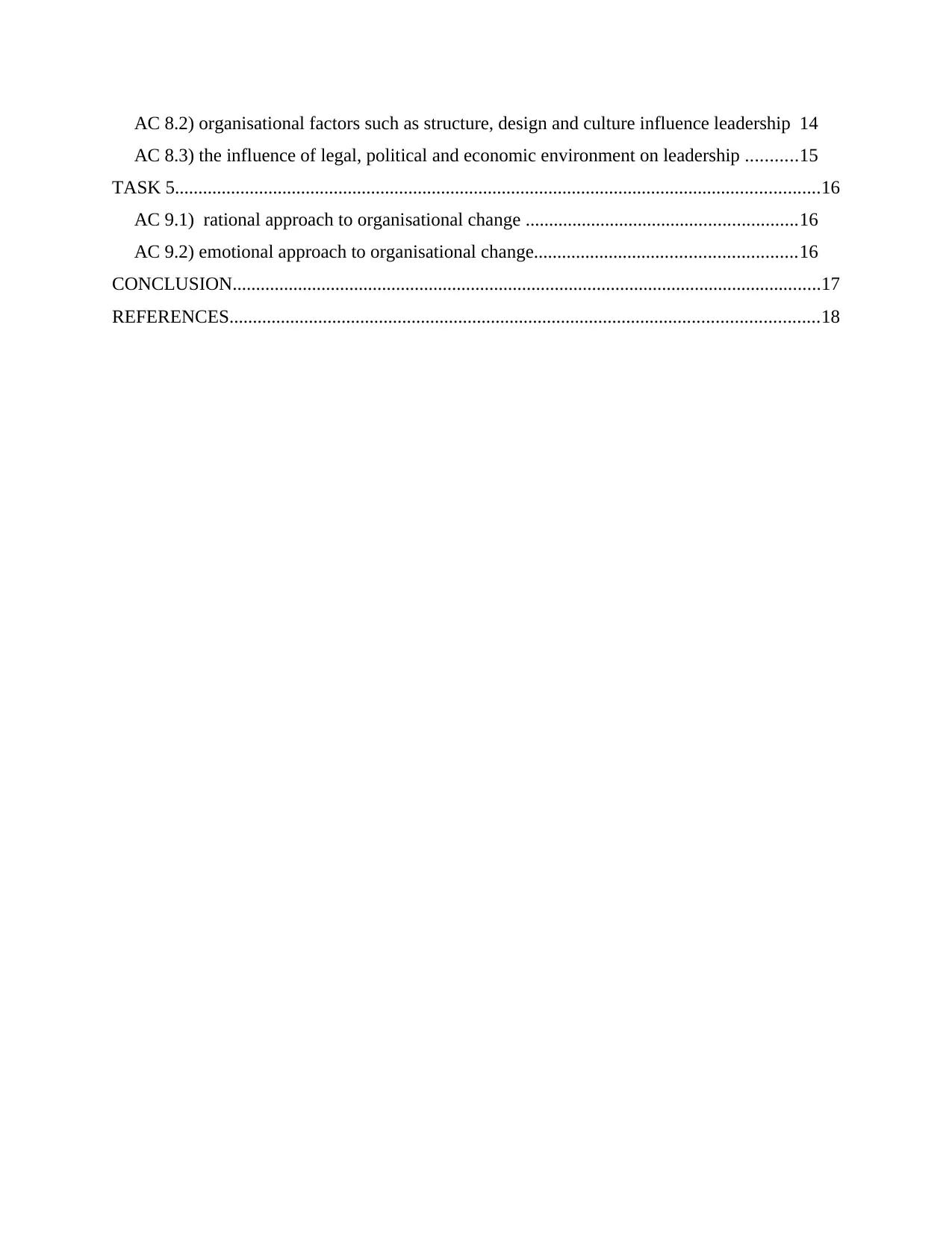
AC 8.2) organisational factors such as structure, design and culture influence leadership 14
AC 8.3) the influence of legal, political and economic environment on leadership ...........15
TASK 5..........................................................................................................................................16
AC 9.1) rational approach to organisational change ..........................................................16
AC 9.2) emotional approach to organisational change........................................................16
CONCLUSION..............................................................................................................................17
REFERENCES..............................................................................................................................18
AC 8.3) the influence of legal, political and economic environment on leadership ...........15
TASK 5..........................................................................................................................................16
AC 9.1) rational approach to organisational change ..........................................................16
AC 9.2) emotional approach to organisational change........................................................16
CONCLUSION..............................................................................................................................17
REFERENCES..............................................................................................................................18
⊘ This is a preview!⊘
Do you want full access?
Subscribe today to unlock all pages.

Trusted by 1+ million students worldwide
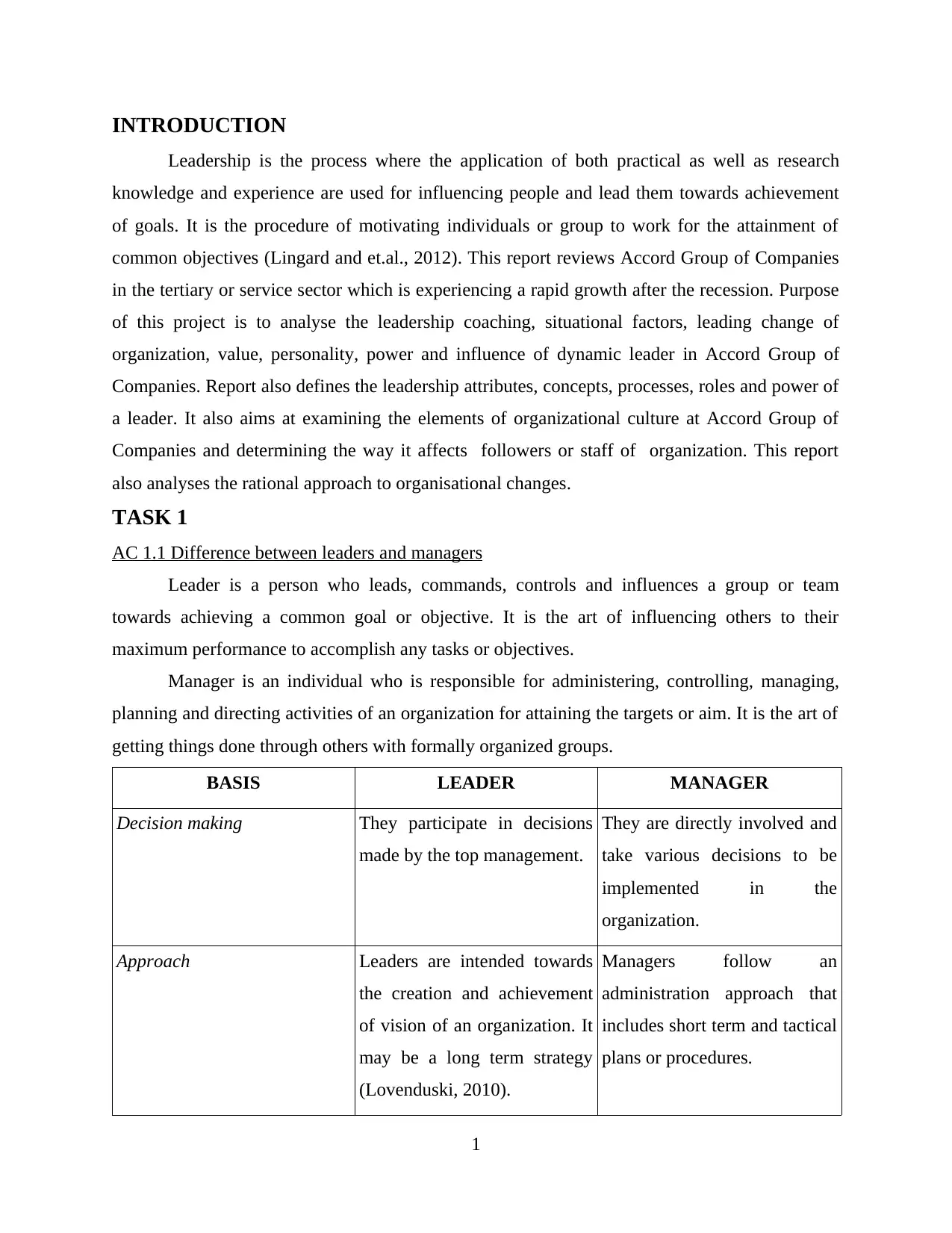
INTRODUCTION
Leadership is the process where the application of both practical as well as research
knowledge and experience are used for influencing people and lead them towards achievement
of goals. It is the procedure of motivating individuals or group to work for the attainment of
common objectives (Lingard and et.al., 2012). This report reviews Accord Group of Companies
in the tertiary or service sector which is experiencing a rapid growth after the recession. Purpose
of this project is to analyse the leadership coaching, situational factors, leading change of
organization, value, personality, power and influence of dynamic leader in Accord Group of
Companies. Report also defines the leadership attributes, concepts, processes, roles and power of
a leader. It also aims at examining the elements of organizational culture at Accord Group of
Companies and determining the way it affects followers or staff of organization. This report
also analyses the rational approach to organisational changes.
TASK 1
AC 1.1 Difference between leaders and managers
Leader is a person who leads, commands, controls and influences a group or team
towards achieving a common goal or objective. It is the art of influencing others to their
maximum performance to accomplish any tasks or objectives.
Manager is an individual who is responsible for administering, controlling, managing,
planning and directing activities of an organization for attaining the targets or aim. It is the art of
getting things done through others with formally organized groups.
BASIS LEADER MANAGER
Decision making They participate in decisions
made by the top management.
They are directly involved and
take various decisions to be
implemented in the
organization.
Approach Leaders are intended towards
the creation and achievement
of vision of an organization. It
may be a long term strategy
(Lovenduski, 2010).
Managers follow an
administration approach that
includes short term and tactical
plans or procedures.
1
Leadership is the process where the application of both practical as well as research
knowledge and experience are used for influencing people and lead them towards achievement
of goals. It is the procedure of motivating individuals or group to work for the attainment of
common objectives (Lingard and et.al., 2012). This report reviews Accord Group of Companies
in the tertiary or service sector which is experiencing a rapid growth after the recession. Purpose
of this project is to analyse the leadership coaching, situational factors, leading change of
organization, value, personality, power and influence of dynamic leader in Accord Group of
Companies. Report also defines the leadership attributes, concepts, processes, roles and power of
a leader. It also aims at examining the elements of organizational culture at Accord Group of
Companies and determining the way it affects followers or staff of organization. This report
also analyses the rational approach to organisational changes.
TASK 1
AC 1.1 Difference between leaders and managers
Leader is a person who leads, commands, controls and influences a group or team
towards achieving a common goal or objective. It is the art of influencing others to their
maximum performance to accomplish any tasks or objectives.
Manager is an individual who is responsible for administering, controlling, managing,
planning and directing activities of an organization for attaining the targets or aim. It is the art of
getting things done through others with formally organized groups.
BASIS LEADER MANAGER
Decision making They participate in decisions
made by the top management.
They are directly involved and
take various decisions to be
implemented in the
organization.
Approach Leaders are intended towards
the creation and achievement
of vision of an organization. It
may be a long term strategy
(Lovenduski, 2010).
Managers follow an
administration approach that
includes short term and tactical
plans or procedures.
1
Paraphrase This Document
Need a fresh take? Get an instant paraphrase of this document with our AI Paraphraser
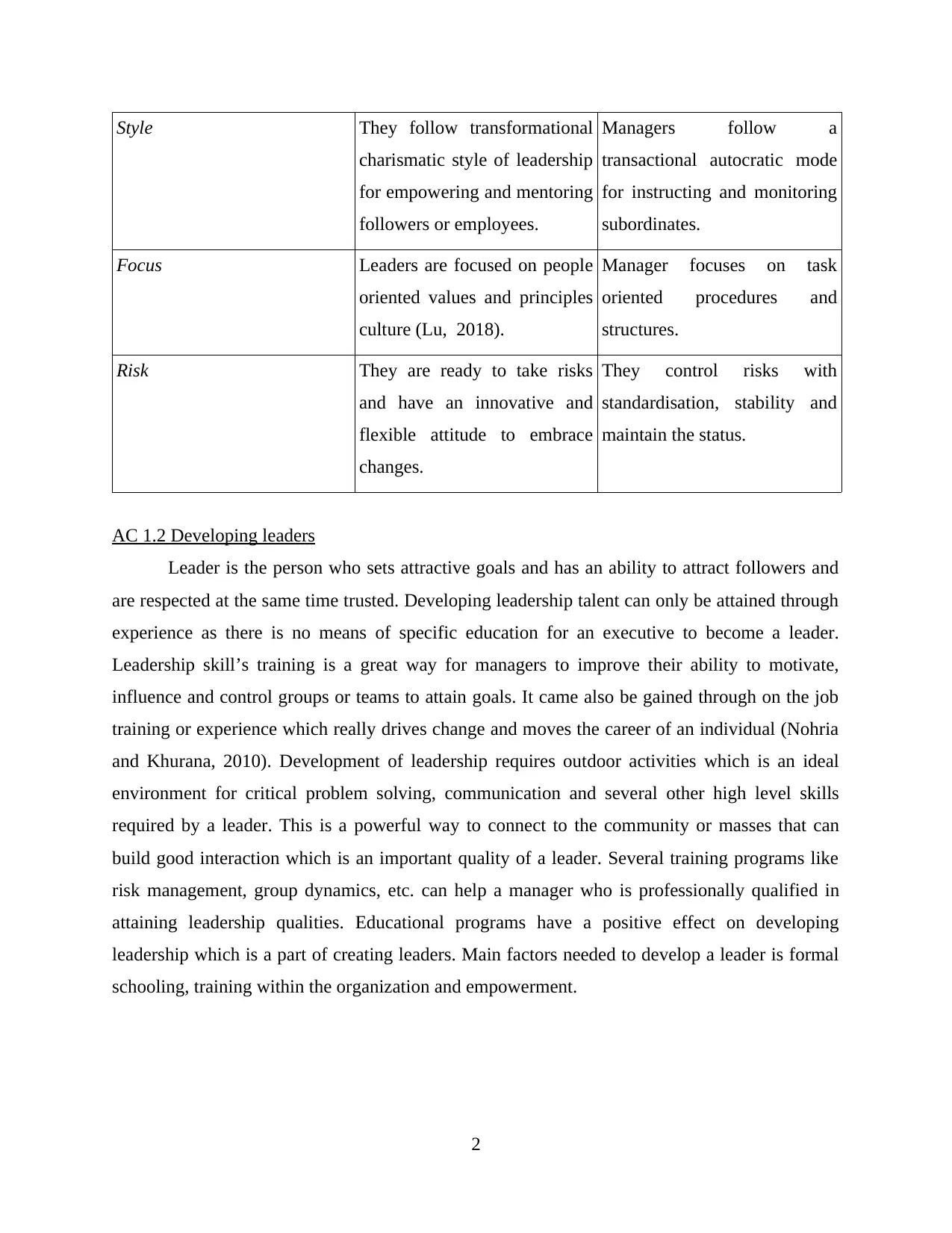
Style They follow transformational
charismatic style of leadership
for empowering and mentoring
followers or employees.
Managers follow a
transactional autocratic mode
for instructing and monitoring
subordinates.
Focus Leaders are focused on people
oriented values and principles
culture (Lu, 2018).
Manager focuses on task
oriented procedures and
structures.
Risk They are ready to take risks
and have an innovative and
flexible attitude to embrace
changes.
They control risks with
standardisation, stability and
maintain the status.
AC 1.2 Developing leaders
Leader is the person who sets attractive goals and has an ability to attract followers and
are respected at the same time trusted. Developing leadership talent can only be attained through
experience as there is no means of specific education for an executive to become a leader.
Leadership skill’s training is a great way for managers to improve their ability to motivate,
influence and control groups or teams to attain goals. It came also be gained through on the job
training or experience which really drives change and moves the career of an individual (Nohria
and Khurana, 2010). Development of leadership requires outdoor activities which is an ideal
environment for critical problem solving, communication and several other high level skills
required by a leader. This is a powerful way to connect to the community or masses that can
build good interaction which is an important quality of a leader. Several training programs like
risk management, group dynamics, etc. can help a manager who is professionally qualified in
attaining leadership qualities. Educational programs have a positive effect on developing
leadership which is a part of creating leaders. Main factors needed to develop a leader is formal
schooling, training within the organization and empowerment.
2
charismatic style of leadership
for empowering and mentoring
followers or employees.
Managers follow a
transactional autocratic mode
for instructing and monitoring
subordinates.
Focus Leaders are focused on people
oriented values and principles
culture (Lu, 2018).
Manager focuses on task
oriented procedures and
structures.
Risk They are ready to take risks
and have an innovative and
flexible attitude to embrace
changes.
They control risks with
standardisation, stability and
maintain the status.
AC 1.2 Developing leaders
Leader is the person who sets attractive goals and has an ability to attract followers and
are respected at the same time trusted. Developing leadership talent can only be attained through
experience as there is no means of specific education for an executive to become a leader.
Leadership skill’s training is a great way for managers to improve their ability to motivate,
influence and control groups or teams to attain goals. It came also be gained through on the job
training or experience which really drives change and moves the career of an individual (Nohria
and Khurana, 2010). Development of leadership requires outdoor activities which is an ideal
environment for critical problem solving, communication and several other high level skills
required by a leader. This is a powerful way to connect to the community or masses that can
build good interaction which is an important quality of a leader. Several training programs like
risk management, group dynamics, etc. can help a manager who is professionally qualified in
attaining leadership qualities. Educational programs have a positive effect on developing
leadership which is a part of creating leaders. Main factors needed to develop a leader is formal
schooling, training within the organization and empowerment.
2
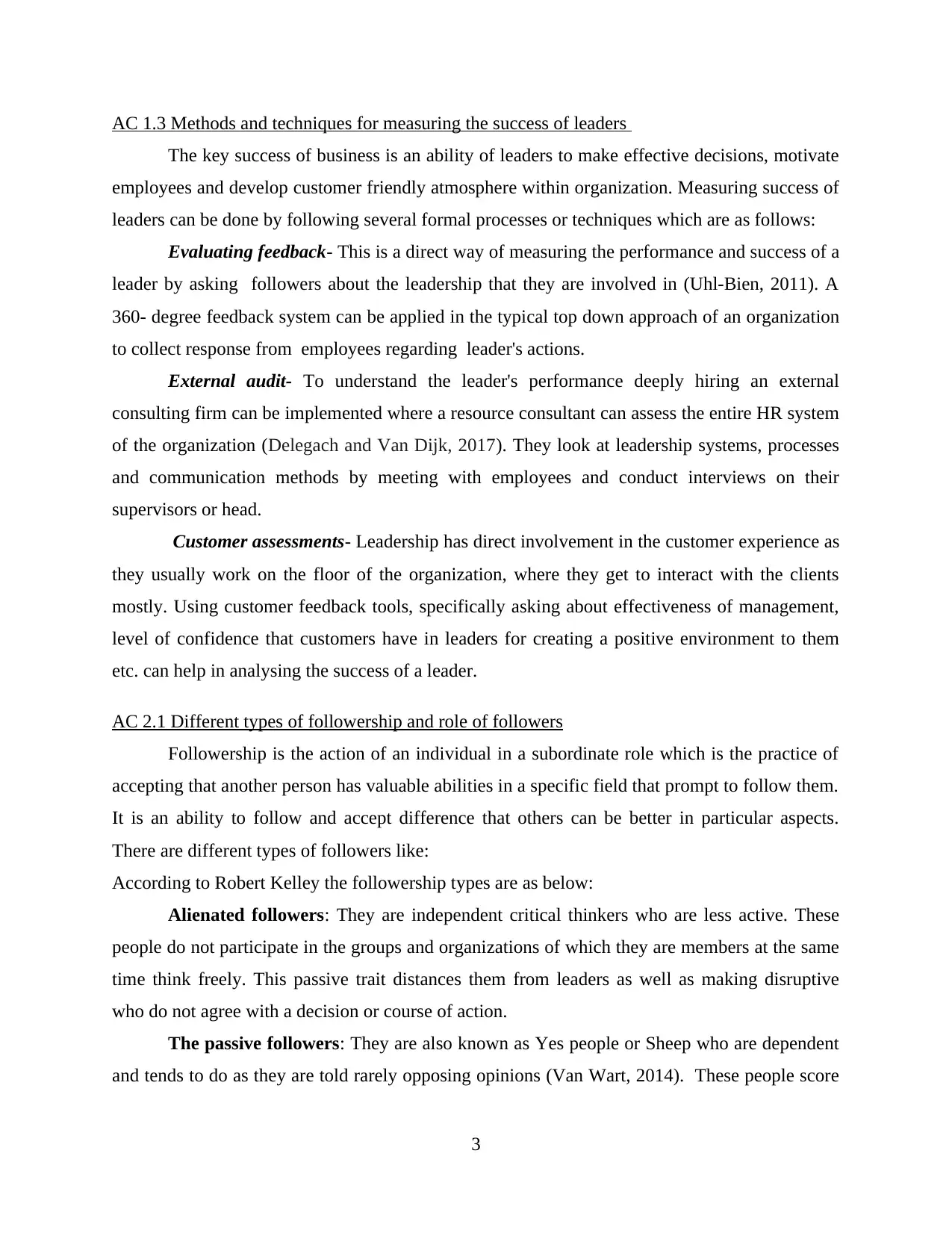
AC 1.3 Methods and techniques for measuring the success of leaders
The key success of business is an ability of leaders to make effective decisions, motivate
employees and develop customer friendly atmosphere within organization. Measuring success of
leaders can be done by following several formal processes or techniques which are as follows:
Evaluating feedback- This is a direct way of measuring the performance and success of a
leader by asking followers about the leadership that they are involved in (Uhl-Bien, 2011). A
360- degree feedback system can be applied in the typical top down approach of an organization
to collect response from employees regarding leader's actions.
External audit- To understand the leader's performance deeply hiring an external
consulting firm can be implemented where a resource consultant can assess the entire HR system
of the organization (Delegach and Van Dijk, 2017). They look at leadership systems, processes
and communication methods by meeting with employees and conduct interviews on their
supervisors or head.
Customer assessments- Leadership has direct involvement in the customer experience as
they usually work on the floor of the organization, where they get to interact with the clients
mostly. Using customer feedback tools, specifically asking about effectiveness of management,
level of confidence that customers have in leaders for creating a positive environment to them
etc. can help in analysing the success of a leader.
AC 2.1 Different types of followership and role of followers
Followership is the action of an individual in a subordinate role which is the practice of
accepting that another person has valuable abilities in a specific field that prompt to follow them.
It is an ability to follow and accept difference that others can be better in particular aspects.
There are different types of followers like:
According to Robert Kelley the followership types are as below:
Alienated followers: They are independent critical thinkers who are less active. These
people do not participate in the groups and organizations of which they are members at the same
time think freely. This passive trait distances them from leaders as well as making disruptive
who do not agree with a decision or course of action.
The passive followers: They are also known as Yes people or Sheep who are dependent
and tends to do as they are told rarely opposing opinions (Van Wart, 2014). These people score
3
The key success of business is an ability of leaders to make effective decisions, motivate
employees and develop customer friendly atmosphere within organization. Measuring success of
leaders can be done by following several formal processes or techniques which are as follows:
Evaluating feedback- This is a direct way of measuring the performance and success of a
leader by asking followers about the leadership that they are involved in (Uhl-Bien, 2011). A
360- degree feedback system can be applied in the typical top down approach of an organization
to collect response from employees regarding leader's actions.
External audit- To understand the leader's performance deeply hiring an external
consulting firm can be implemented where a resource consultant can assess the entire HR system
of the organization (Delegach and Van Dijk, 2017). They look at leadership systems, processes
and communication methods by meeting with employees and conduct interviews on their
supervisors or head.
Customer assessments- Leadership has direct involvement in the customer experience as
they usually work on the floor of the organization, where they get to interact with the clients
mostly. Using customer feedback tools, specifically asking about effectiveness of management,
level of confidence that customers have in leaders for creating a positive environment to them
etc. can help in analysing the success of a leader.
AC 2.1 Different types of followership and role of followers
Followership is the action of an individual in a subordinate role which is the practice of
accepting that another person has valuable abilities in a specific field that prompt to follow them.
It is an ability to follow and accept difference that others can be better in particular aspects.
There are different types of followers like:
According to Robert Kelley the followership types are as below:
Alienated followers: They are independent critical thinkers who are less active. These
people do not participate in the groups and organizations of which they are members at the same
time think freely. This passive trait distances them from leaders as well as making disruptive
who do not agree with a decision or course of action.
The passive followers: They are also known as Yes people or Sheep who are dependent
and tends to do as they are told rarely opposing opinions (Van Wart, 2014). These people score
3
⊘ This is a preview!⊘
Do you want full access?
Subscribe today to unlock all pages.

Trusted by 1+ million students worldwide
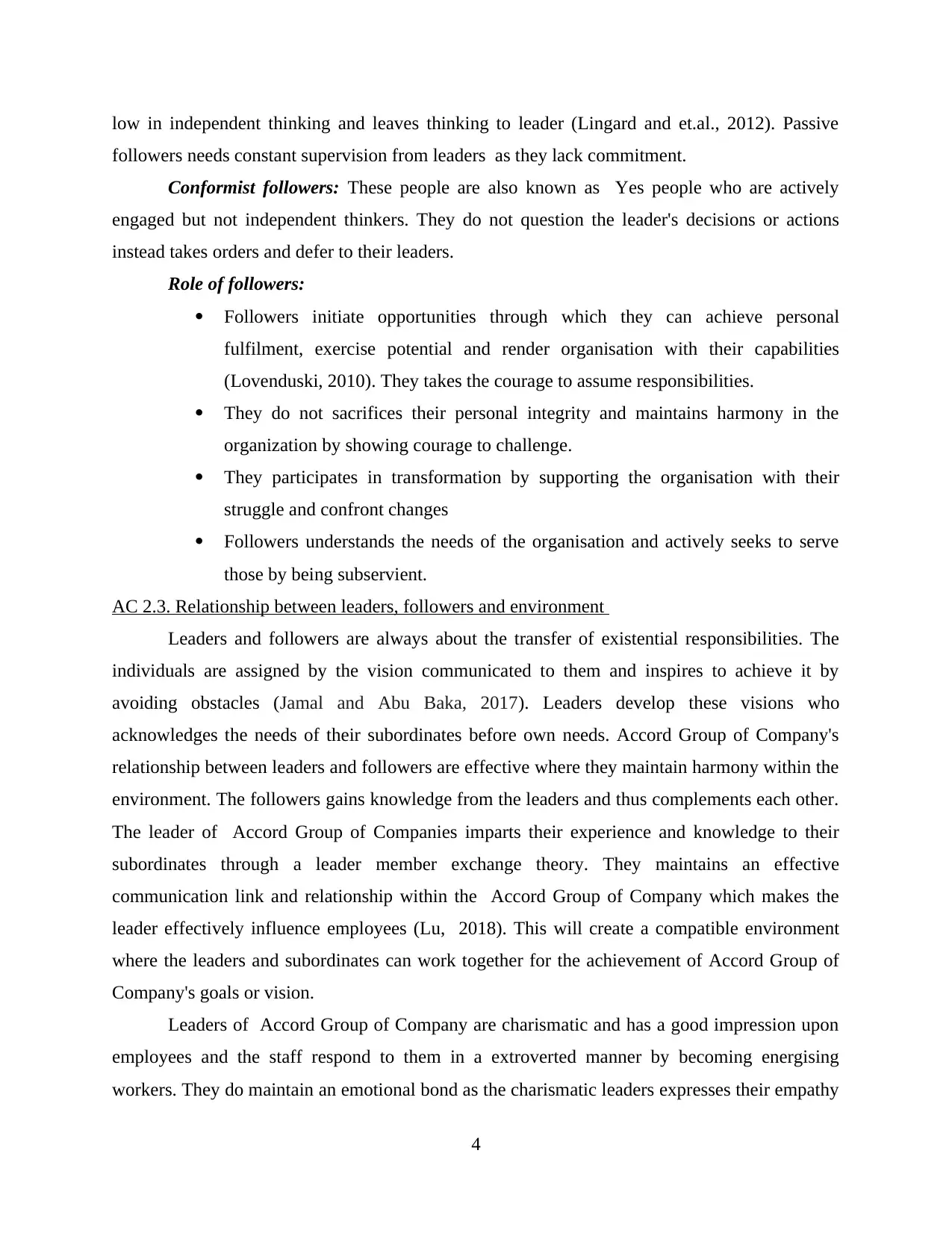
low in independent thinking and leaves thinking to leader (Lingard and et.al., 2012). Passive
followers needs constant supervision from leaders as they lack commitment.
Conformist followers: These people are also known as Yes people who are actively
engaged but not independent thinkers. They do not question the leader's decisions or actions
instead takes orders and defer to their leaders.
Role of followers:
Followers initiate opportunities through which they can achieve personal
fulfilment, exercise potential and render organisation with their capabilities
(Lovenduski, 2010). They takes the courage to assume responsibilities.
They do not sacrifices their personal integrity and maintains harmony in the
organization by showing courage to challenge.
They participates in transformation by supporting the organisation with their
struggle and confront changes
Followers understands the needs of the organisation and actively seeks to serve
those by being subservient.
AC 2.3. Relationship between leaders, followers and environment
Leaders and followers are always about the transfer of existential responsibilities. The
individuals are assigned by the vision communicated to them and inspires to achieve it by
avoiding obstacles (Jamal and Abu Baka, 2017). Leaders develop these visions who
acknowledges the needs of their subordinates before own needs. Accord Group of Company's
relationship between leaders and followers are effective where they maintain harmony within the
environment. The followers gains knowledge from the leaders and thus complements each other.
The leader of Accord Group of Companies imparts their experience and knowledge to their
subordinates through a leader member exchange theory. They maintains an effective
communication link and relationship within the Accord Group of Company which makes the
leader effectively influence employees (Lu, 2018). This will create a compatible environment
where the leaders and subordinates can work together for the achievement of Accord Group of
Company's goals or vision.
Leaders of Accord Group of Company are charismatic and has a good impression upon
employees and the staff respond to them in a extroverted manner by becoming energising
workers. They do maintain an emotional bond as the charismatic leaders expresses their empathy
4
followers needs constant supervision from leaders as they lack commitment.
Conformist followers: These people are also known as Yes people who are actively
engaged but not independent thinkers. They do not question the leader's decisions or actions
instead takes orders and defer to their leaders.
Role of followers:
Followers initiate opportunities through which they can achieve personal
fulfilment, exercise potential and render organisation with their capabilities
(Lovenduski, 2010). They takes the courage to assume responsibilities.
They do not sacrifices their personal integrity and maintains harmony in the
organization by showing courage to challenge.
They participates in transformation by supporting the organisation with their
struggle and confront changes
Followers understands the needs of the organisation and actively seeks to serve
those by being subservient.
AC 2.3. Relationship between leaders, followers and environment
Leaders and followers are always about the transfer of existential responsibilities. The
individuals are assigned by the vision communicated to them and inspires to achieve it by
avoiding obstacles (Jamal and Abu Baka, 2017). Leaders develop these visions who
acknowledges the needs of their subordinates before own needs. Accord Group of Company's
relationship between leaders and followers are effective where they maintain harmony within the
environment. The followers gains knowledge from the leaders and thus complements each other.
The leader of Accord Group of Companies imparts their experience and knowledge to their
subordinates through a leader member exchange theory. They maintains an effective
communication link and relationship within the Accord Group of Company which makes the
leader effectively influence employees (Lu, 2018). This will create a compatible environment
where the leaders and subordinates can work together for the achievement of Accord Group of
Company's goals or vision.
Leaders of Accord Group of Company are charismatic and has a good impression upon
employees and the staff respond to them in a extroverted manner by becoming energising
workers. They do maintain an emotional bond as the charismatic leaders expresses their empathy
4
Paraphrase This Document
Need a fresh take? Get an instant paraphrase of this document with our AI Paraphraser
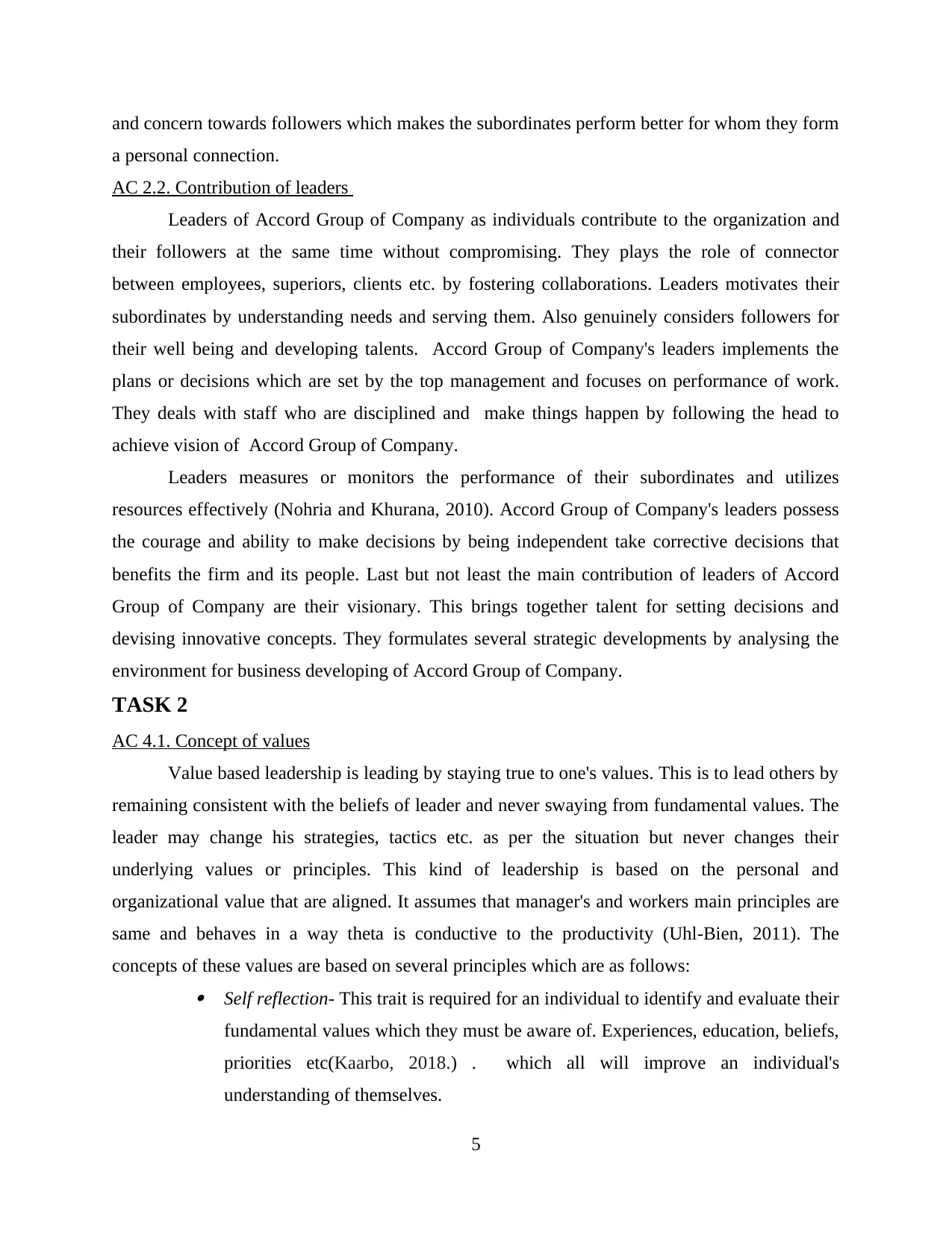
and concern towards followers which makes the subordinates perform better for whom they form
a personal connection.
AC 2.2. Contribution of leaders
Leaders of Accord Group of Company as individuals contribute to the organization and
their followers at the same time without compromising. They plays the role of connector
between employees, superiors, clients etc. by fostering collaborations. Leaders motivates their
subordinates by understanding needs and serving them. Also genuinely considers followers for
their well being and developing talents. Accord Group of Company's leaders implements the
plans or decisions which are set by the top management and focuses on performance of work.
They deals with staff who are disciplined and make things happen by following the head to
achieve vision of Accord Group of Company.
Leaders measures or monitors the performance of their subordinates and utilizes
resources effectively (Nohria and Khurana, 2010). Accord Group of Company's leaders possess
the courage and ability to make decisions by being independent take corrective decisions that
benefits the firm and its people. Last but not least the main contribution of leaders of Accord
Group of Company are their visionary. This brings together talent for setting decisions and
devising innovative concepts. They formulates several strategic developments by analysing the
environment for business developing of Accord Group of Company.
TASK 2
AC 4.1. Concept of values
Value based leadership is leading by staying true to one's values. This is to lead others by
remaining consistent with the beliefs of leader and never swaying from fundamental values. The
leader may change his strategies, tactics etc. as per the situation but never changes their
underlying values or principles. This kind of leadership is based on the personal and
organizational value that are aligned. It assumes that manager's and workers main principles are
same and behaves in a way theta is conductive to the productivity (Uhl-Bien, 2011). The
concepts of these values are based on several principles which are as follows:
Self reflection- This trait is required for an individual to identify and evaluate their
fundamental values which they must be aware of. Experiences, education, beliefs,
priorities etc(Kaarbo, 2018.) . which all will improve an individual's
understanding of themselves.
5
a personal connection.
AC 2.2. Contribution of leaders
Leaders of Accord Group of Company as individuals contribute to the organization and
their followers at the same time without compromising. They plays the role of connector
between employees, superiors, clients etc. by fostering collaborations. Leaders motivates their
subordinates by understanding needs and serving them. Also genuinely considers followers for
their well being and developing talents. Accord Group of Company's leaders implements the
plans or decisions which are set by the top management and focuses on performance of work.
They deals with staff who are disciplined and make things happen by following the head to
achieve vision of Accord Group of Company.
Leaders measures or monitors the performance of their subordinates and utilizes
resources effectively (Nohria and Khurana, 2010). Accord Group of Company's leaders possess
the courage and ability to make decisions by being independent take corrective decisions that
benefits the firm and its people. Last but not least the main contribution of leaders of Accord
Group of Company are their visionary. This brings together talent for setting decisions and
devising innovative concepts. They formulates several strategic developments by analysing the
environment for business developing of Accord Group of Company.
TASK 2
AC 4.1. Concept of values
Value based leadership is leading by staying true to one's values. This is to lead others by
remaining consistent with the beliefs of leader and never swaying from fundamental values. The
leader may change his strategies, tactics etc. as per the situation but never changes their
underlying values or principles. This kind of leadership is based on the personal and
organizational value that are aligned. It assumes that manager's and workers main principles are
same and behaves in a way theta is conductive to the productivity (Uhl-Bien, 2011). The
concepts of these values are based on several principles which are as follows:
Self reflection- This trait is required for an individual to identify and evaluate their
fundamental values which they must be aware of. Experiences, education, beliefs,
priorities etc(Kaarbo, 2018.) . which all will improve an individual's
understanding of themselves.
5
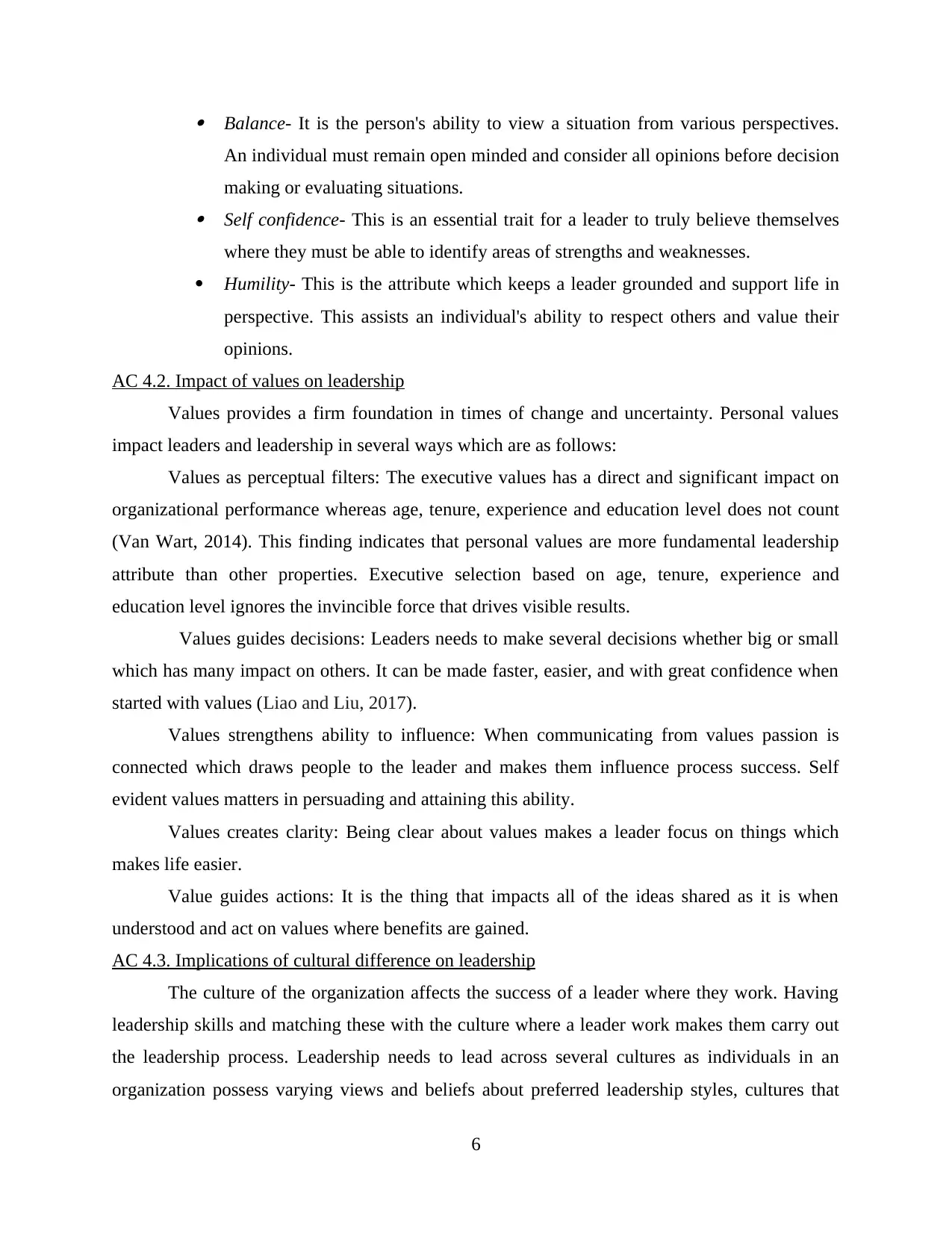
Balance- It is the person's ability to view a situation from various perspectives.
An individual must remain open minded and consider all opinions before decision
making or evaluating situations.
Self confidence- This is an essential trait for a leader to truly believe themselves
where they must be able to identify areas of strengths and weaknesses.
Humility- This is the attribute which keeps a leader grounded and support life in
perspective. This assists an individual's ability to respect others and value their
opinions.
AC 4.2. Impact of values on leadership
Values provides a firm foundation in times of change and uncertainty. Personal values
impact leaders and leadership in several ways which are as follows:
Values as perceptual filters: The executive values has a direct and significant impact on
organizational performance whereas age, tenure, experience and education level does not count
(Van Wart, 2014). This finding indicates that personal values are more fundamental leadership
attribute than other properties. Executive selection based on age, tenure, experience and
education level ignores the invincible force that drives visible results.
Values guides decisions: Leaders needs to make several decisions whether big or small
which has many impact on others. It can be made faster, easier, and with great confidence when
started with values (Liao and Liu, 2017).
Values strengthens ability to influence: When communicating from values passion is
connected which draws people to the leader and makes them influence process success. Self
evident values matters in persuading and attaining this ability.
Values creates clarity: Being clear about values makes a leader focus on things which
makes life easier.
Value guides actions: It is the thing that impacts all of the ideas shared as it is when
understood and act on values where benefits are gained.
AC 4.3. Implications of cultural difference on leadership
The culture of the organization affects the success of a leader where they work. Having
leadership skills and matching these with the culture where a leader work makes them carry out
the leadership process. Leadership needs to lead across several cultures as individuals in an
organization possess varying views and beliefs about preferred leadership styles, cultures that
6
An individual must remain open minded and consider all opinions before decision
making or evaluating situations.
Self confidence- This is an essential trait for a leader to truly believe themselves
where they must be able to identify areas of strengths and weaknesses.
Humility- This is the attribute which keeps a leader grounded and support life in
perspective. This assists an individual's ability to respect others and value their
opinions.
AC 4.2. Impact of values on leadership
Values provides a firm foundation in times of change and uncertainty. Personal values
impact leaders and leadership in several ways which are as follows:
Values as perceptual filters: The executive values has a direct and significant impact on
organizational performance whereas age, tenure, experience and education level does not count
(Van Wart, 2014). This finding indicates that personal values are more fundamental leadership
attribute than other properties. Executive selection based on age, tenure, experience and
education level ignores the invincible force that drives visible results.
Values guides decisions: Leaders needs to make several decisions whether big or small
which has many impact on others. It can be made faster, easier, and with great confidence when
started with values (Liao and Liu, 2017).
Values strengthens ability to influence: When communicating from values passion is
connected which draws people to the leader and makes them influence process success. Self
evident values matters in persuading and attaining this ability.
Values creates clarity: Being clear about values makes a leader focus on things which
makes life easier.
Value guides actions: It is the thing that impacts all of the ideas shared as it is when
understood and act on values where benefits are gained.
AC 4.3. Implications of cultural difference on leadership
The culture of the organization affects the success of a leader where they work. Having
leadership skills and matching these with the culture where a leader work makes them carry out
the leadership process. Leadership needs to lead across several cultures as individuals in an
organization possess varying views and beliefs about preferred leadership styles, cultures that
6
⊘ This is a preview!⊘
Do you want full access?
Subscribe today to unlock all pages.

Trusted by 1+ million students worldwide
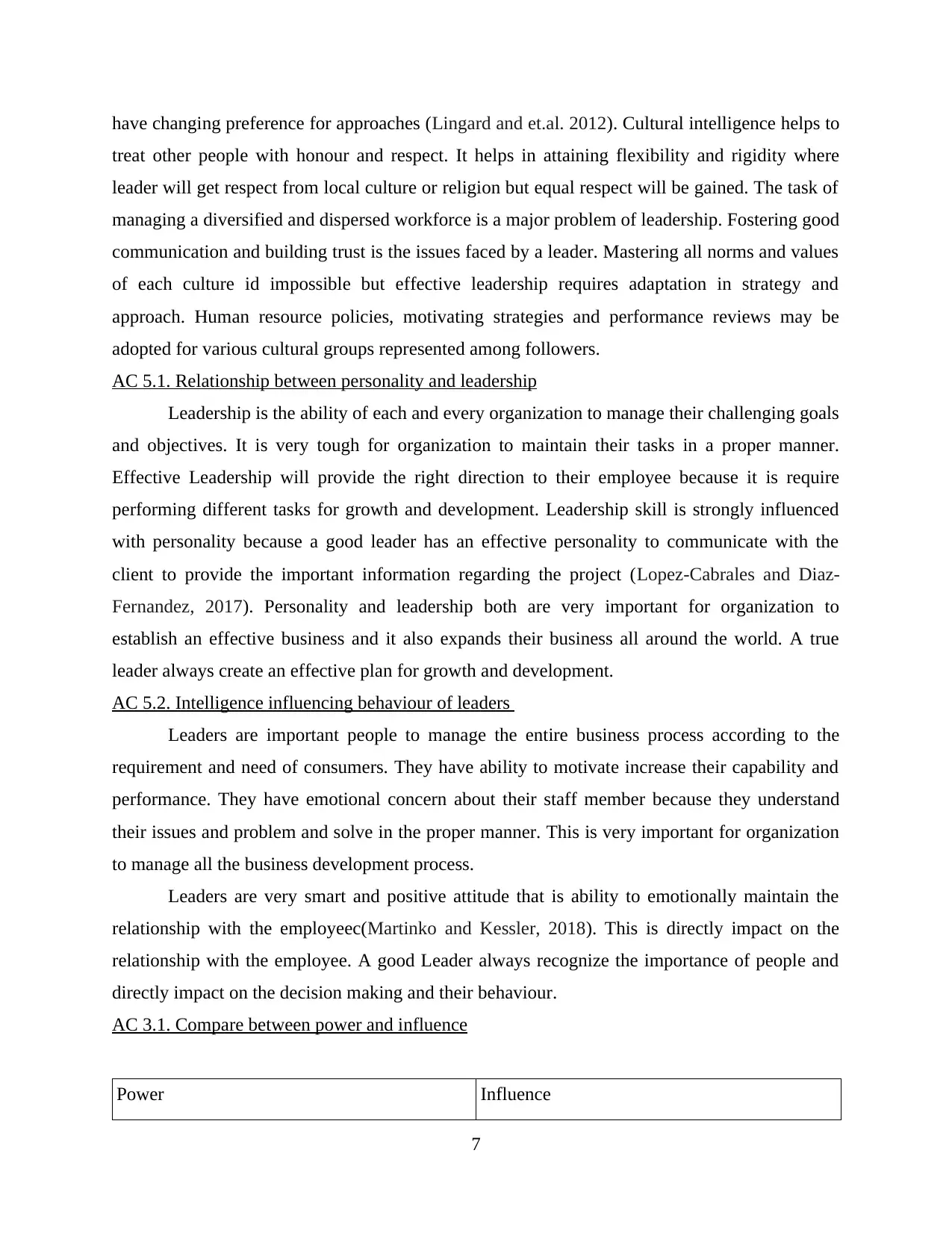
have changing preference for approaches (Lingard and et.al. 2012). Cultural intelligence helps to
treat other people with honour and respect. It helps in attaining flexibility and rigidity where
leader will get respect from local culture or religion but equal respect will be gained. The task of
managing a diversified and dispersed workforce is a major problem of leadership. Fostering good
communication and building trust is the issues faced by a leader. Mastering all norms and values
of each culture id impossible but effective leadership requires adaptation in strategy and
approach. Human resource policies, motivating strategies and performance reviews may be
adopted for various cultural groups represented among followers.
AC 5.1. Relationship between personality and leadership
Leadership is the ability of each and every organization to manage their challenging goals
and objectives. It is very tough for organization to maintain their tasks in a proper manner.
Effective Leadership will provide the right direction to their employee because it is require
performing different tasks for growth and development. Leadership skill is strongly influenced
with personality because a good leader has an effective personality to communicate with the
client to provide the important information regarding the project (Lopez-Cabrales and Diaz-
Fernandez, 2017). Personality and leadership both are very important for organization to
establish an effective business and it also expands their business all around the world. A true
leader always create an effective plan for growth and development.
AC 5.2. Intelligence influencing behaviour of leaders
Leaders are important people to manage the entire business process according to the
requirement and need of consumers. They have ability to motivate increase their capability and
performance. They have emotional concern about their staff member because they understand
their issues and problem and solve in the proper manner. This is very important for organization
to manage all the business development process.
Leaders are very smart and positive attitude that is ability to emotionally maintain the
relationship with the employeec(Martinko and Kessler, 2018). This is directly impact on the
relationship with the employee. A good Leader always recognize the importance of people and
directly impact on the decision making and their behaviour.
AC 3.1. Compare between power and influence
Power Influence
7
treat other people with honour and respect. It helps in attaining flexibility and rigidity where
leader will get respect from local culture or religion but equal respect will be gained. The task of
managing a diversified and dispersed workforce is a major problem of leadership. Fostering good
communication and building trust is the issues faced by a leader. Mastering all norms and values
of each culture id impossible but effective leadership requires adaptation in strategy and
approach. Human resource policies, motivating strategies and performance reviews may be
adopted for various cultural groups represented among followers.
AC 5.1. Relationship between personality and leadership
Leadership is the ability of each and every organization to manage their challenging goals
and objectives. It is very tough for organization to maintain their tasks in a proper manner.
Effective Leadership will provide the right direction to their employee because it is require
performing different tasks for growth and development. Leadership skill is strongly influenced
with personality because a good leader has an effective personality to communicate with the
client to provide the important information regarding the project (Lopez-Cabrales and Diaz-
Fernandez, 2017). Personality and leadership both are very important for organization to
establish an effective business and it also expands their business all around the world. A true
leader always create an effective plan for growth and development.
AC 5.2. Intelligence influencing behaviour of leaders
Leaders are important people to manage the entire business process according to the
requirement and need of consumers. They have ability to motivate increase their capability and
performance. They have emotional concern about their staff member because they understand
their issues and problem and solve in the proper manner. This is very important for organization
to manage all the business development process.
Leaders are very smart and positive attitude that is ability to emotionally maintain the
relationship with the employeec(Martinko and Kessler, 2018). This is directly impact on the
relationship with the employee. A good Leader always recognize the importance of people and
directly impact on the decision making and their behaviour.
AC 3.1. Compare between power and influence
Power Influence
7
Paraphrase This Document
Need a fresh take? Get an instant paraphrase of this document with our AI Paraphraser
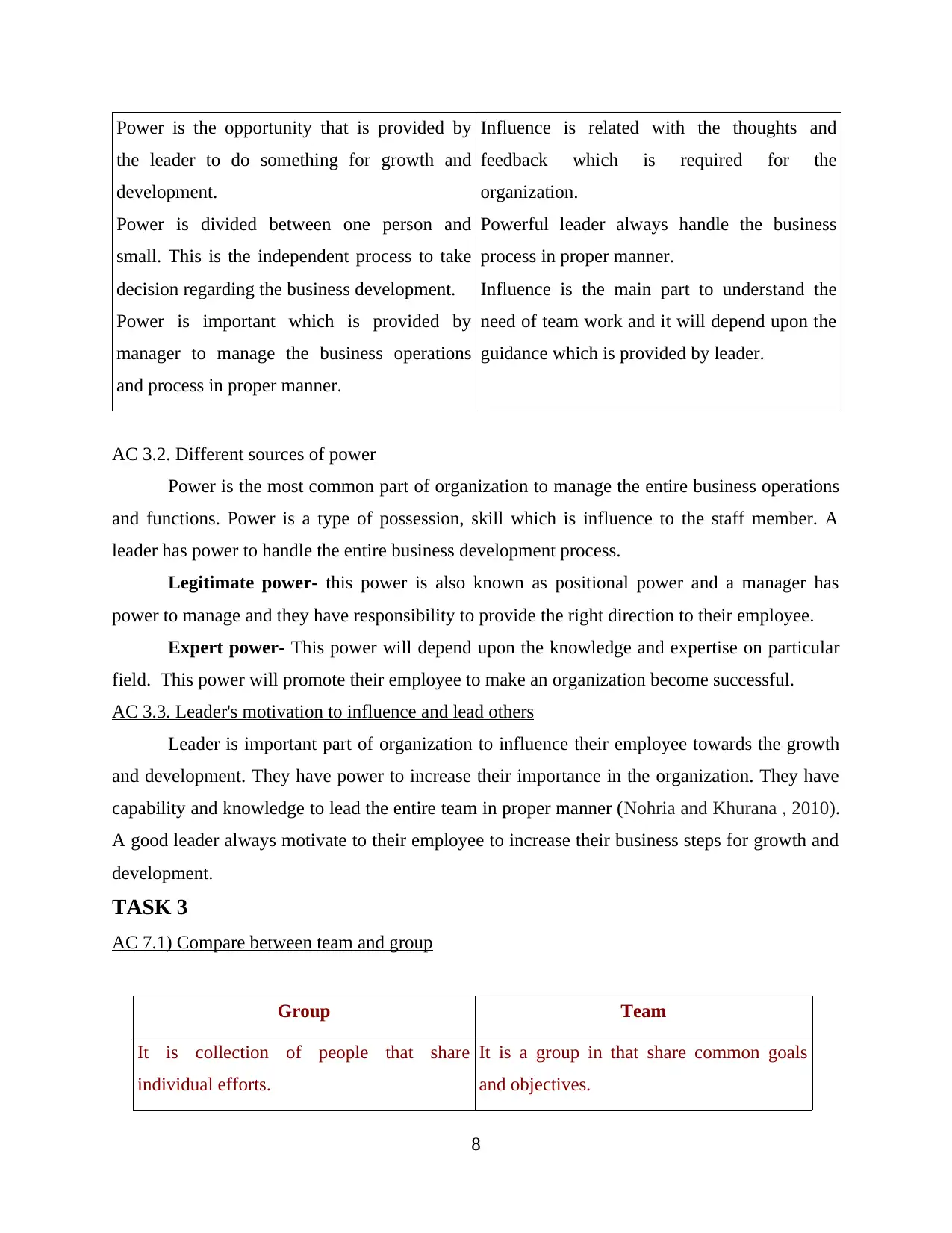
Power is the opportunity that is provided by
the leader to do something for growth and
development.
Power is divided between one person and
small. This is the independent process to take
decision regarding the business development.
Power is important which is provided by
manager to manage the business operations
and process in proper manner.
Influence is related with the thoughts and
feedback which is required for the
organization.
Powerful leader always handle the business
process in proper manner.
Influence is the main part to understand the
need of team work and it will depend upon the
guidance which is provided by leader.
AC 3.2. Different sources of power
Power is the most common part of organization to manage the entire business operations
and functions. Power is a type of possession, skill which is influence to the staff member. A
leader has power to handle the entire business development process.
Legitimate power- this power is also known as positional power and a manager has
power to manage and they have responsibility to provide the right direction to their employee.
Expert power- This power will depend upon the knowledge and expertise on particular
field. This power will promote their employee to make an organization become successful.
AC 3.3. Leader's motivation to influence and lead others
Leader is important part of organization to influence their employee towards the growth
and development. They have power to increase their importance in the organization. They have
capability and knowledge to lead the entire team in proper manner (Nohria and Khurana , 2010).
A good leader always motivate to their employee to increase their business steps for growth and
development.
TASK 3
AC 7.1) Compare between team and group
Group Team
It is collection of people that share
individual efforts.
It is a group in that share common goals
and objectives.
8
the leader to do something for growth and
development.
Power is divided between one person and
small. This is the independent process to take
decision regarding the business development.
Power is important which is provided by
manager to manage the business operations
and process in proper manner.
Influence is related with the thoughts and
feedback which is required for the
organization.
Powerful leader always handle the business
process in proper manner.
Influence is the main part to understand the
need of team work and it will depend upon the
guidance which is provided by leader.
AC 3.2. Different sources of power
Power is the most common part of organization to manage the entire business operations
and functions. Power is a type of possession, skill which is influence to the staff member. A
leader has power to handle the entire business development process.
Legitimate power- this power is also known as positional power and a manager has
power to manage and they have responsibility to provide the right direction to their employee.
Expert power- This power will depend upon the knowledge and expertise on particular
field. This power will promote their employee to make an organization become successful.
AC 3.3. Leader's motivation to influence and lead others
Leader is important part of organization to influence their employee towards the growth
and development. They have power to increase their importance in the organization. They have
capability and knowledge to lead the entire team in proper manner (Nohria and Khurana , 2010).
A good leader always motivate to their employee to increase their business steps for growth and
development.
TASK 3
AC 7.1) Compare between team and group
Group Team
It is collection of people that share
individual efforts.
It is a group in that share common goals
and objectives.
8
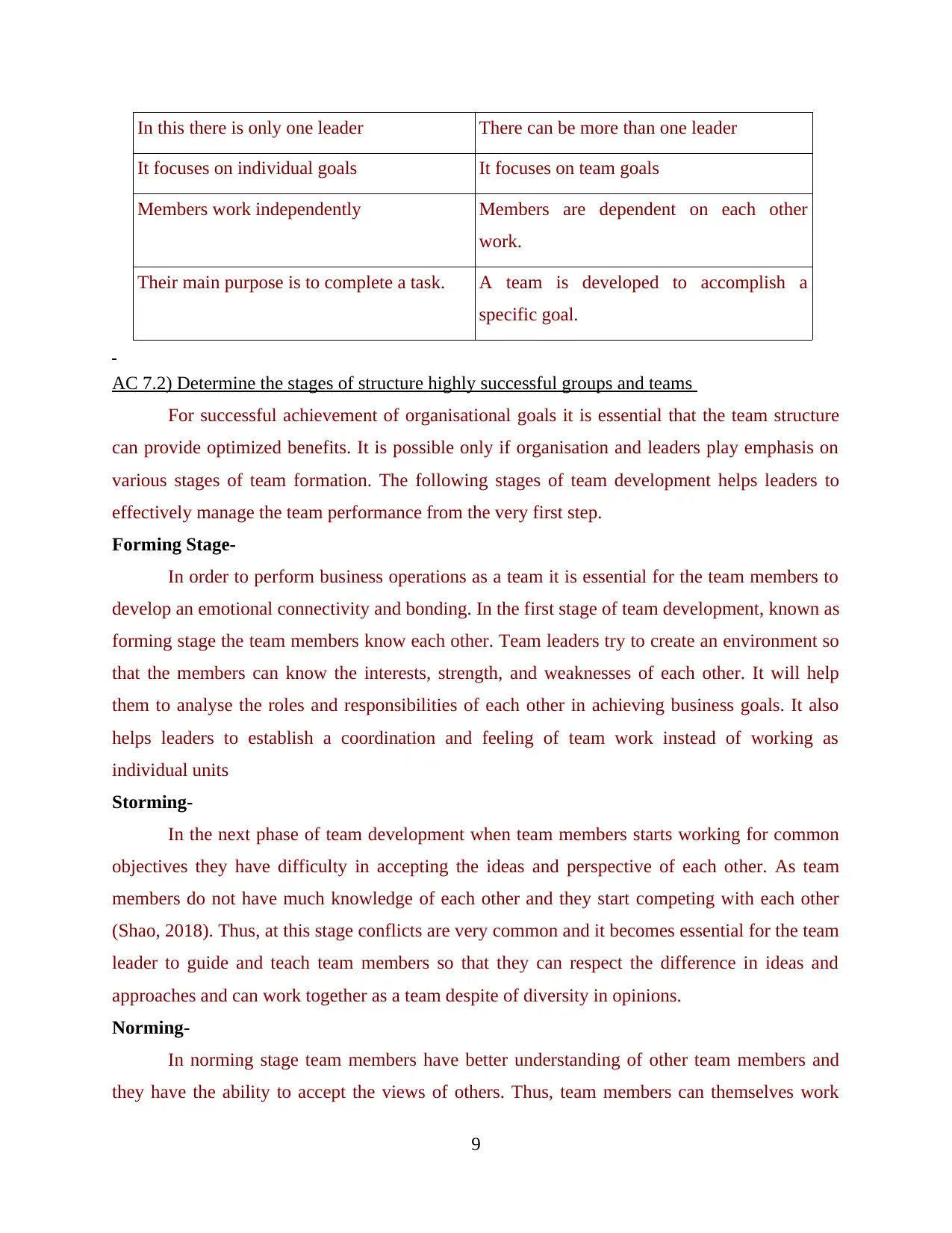
In this there is only one leader There can be more than one leader
It focuses on individual goals It focuses on team goals
Members work independently Members are dependent on each other
work.
Their main purpose is to complete a task. A team is developed to accomplish a
specific goal.
AC 7.2) Determine the stages of structure highly successful groups and teams
For successful achievement of organisational goals it is essential that the team structure
can provide optimized benefits. It is possible only if organisation and leaders play emphasis on
various stages of team formation. The following stages of team development helps leaders to
effectively manage the team performance from the very first step.
Forming Stage-
In order to perform business operations as a team it is essential for the team members to
develop an emotional connectivity and bonding. In the first stage of team development, known as
forming stage the team members know each other. Team leaders try to create an environment so
that the members can know the interests, strength, and weaknesses of each other. It will help
them to analyse the roles and responsibilities of each other in achieving business goals. It also
helps leaders to establish a coordination and feeling of team work instead of working as
individual units
Storming-
In the next phase of team development when team members starts working for common
objectives they have difficulty in accepting the ideas and perspective of each other. As team
members do not have much knowledge of each other and they start competing with each other
(Shao, 2018). Thus, at this stage conflicts are very common and it becomes essential for the team
leader to guide and teach team members so that they can respect the difference in ideas and
approaches and can work together as a team despite of diversity in opinions.
Norming-
In norming stage team members have better understanding of other team members and
they have the ability to accept the views of others. Thus, team members can themselves work
9
It focuses on individual goals It focuses on team goals
Members work independently Members are dependent on each other
work.
Their main purpose is to complete a task. A team is developed to accomplish a
specific goal.
AC 7.2) Determine the stages of structure highly successful groups and teams
For successful achievement of organisational goals it is essential that the team structure
can provide optimized benefits. It is possible only if organisation and leaders play emphasis on
various stages of team formation. The following stages of team development helps leaders to
effectively manage the team performance from the very first step.
Forming Stage-
In order to perform business operations as a team it is essential for the team members to
develop an emotional connectivity and bonding. In the first stage of team development, known as
forming stage the team members know each other. Team leaders try to create an environment so
that the members can know the interests, strength, and weaknesses of each other. It will help
them to analyse the roles and responsibilities of each other in achieving business goals. It also
helps leaders to establish a coordination and feeling of team work instead of working as
individual units
Storming-
In the next phase of team development when team members starts working for common
objectives they have difficulty in accepting the ideas and perspective of each other. As team
members do not have much knowledge of each other and they start competing with each other
(Shao, 2018). Thus, at this stage conflicts are very common and it becomes essential for the team
leader to guide and teach team members so that they can respect the difference in ideas and
approaches and can work together as a team despite of diversity in opinions.
Norming-
In norming stage team members have better understanding of other team members and
they have the ability to accept the views of others. Thus, team members can themselves work
9
⊘ This is a preview!⊘
Do you want full access?
Subscribe today to unlock all pages.

Trusted by 1+ million students worldwide
1 out of 22
Related Documents
Your All-in-One AI-Powered Toolkit for Academic Success.
+13062052269
info@desklib.com
Available 24*7 on WhatsApp / Email
![[object Object]](/_next/static/media/star-bottom.7253800d.svg)
Unlock your academic potential
Copyright © 2020–2025 A2Z Services. All Rights Reserved. Developed and managed by ZUCOL.





